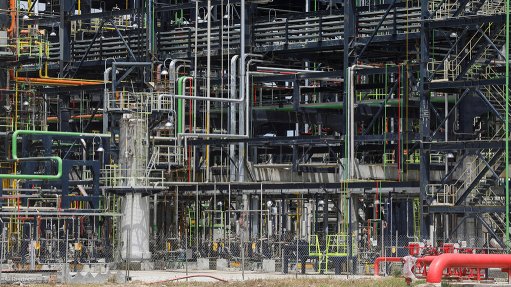Low kimberlite discovery rate seen sparking diamond production crisis by turn of decade
The stability of the diamond sector has always been a slave to the fine balance between supply and demand. Over the last century, the industry has had to contend with various crises of oversupply, largely spurred by conflict, global economic instability and the vagaries of consumer demand. As a result, it has been at the mercy of drastic price troughs.
The most recent crisis, spurred by the 2008 global financial recession and a sharp fall in gem prices in 2011, is still fresh in the mind of the industry, although there are definite signs that the sector is beginning to recover with steady growth of consumer demand, and the stabilisation and steady increase of diamond prices.
De Beers’ recently published Diamond Insight Report 2014 reveals that global demand for diamond jewellery reached a record high of $79-billion in 2013. The report also states that demand is expected to continue to grow over the long term, driven by ongoing economic recovery in the US, as well as the growth of the middle classes in developing markets, such as China and India.
However, while recovery is expected to continue for the next four years, which will facilitate a more balanced market, there is growing consensus among analysts and industry stakeholders that a new spectre – that of waning production – now looms on the horizon and threatens to disrupt that recently restored balance by the close of the decade.
The Diamond Insight Report reveals that global rough diamond production has already begun to decline from a peak of 175-million carats in 2005 to 145-million carats in 2013. The report also states that the forecast reduction in supply from existing sources is not likely to be matched by new production coming on stream in the years ahead; diamond supply is expected to plateau in the second half of the decade before it is expected to decline from 2020.
Speaking at the Kimberley Diamond Symposium 2014 last month, junior miner Tsodilo Resources president and COO Michiel de Wit elaborated that, while there are several new projects set to come into production over the next few years – including the Grib mine, in Russia; the Botuobinskaya project, in Siberia; the Gahcho Kué, Renard and Jay mines, in Canada; as well as the Lace, Liqhobong, and Ghagoo mines, in Southern Africa – these projects are quite small and will only add some 17-million carats a year to global production.
“Cumulatively, these projects will not have a major effect on the steady decline on production of rough [diamonds], and the downward trend is forecast to accelerate over the next few years,” warned De Wit.
He further emphasised that the widening gap between supply and demand is a reality, which “will not do the diamond industry any good, as it will open a feed for synthetics and recycling”.
Downward Slump
The looming production crisis can be attributed to the significantly low discovery rate of economically viable kimberlites since the turn of the century.
De Wit states that even new projects coming into production consist of kimberlites that were found decades ago.
Interestingly, since the discovery of the first diamondiferous kimberlite pipes in the Northern Cape in the 1870s, more than 8 000 kimberlites and lamproites have been discovered worldwide, 43% of which are directly attributable to De Beers’ exploration efforts over the past five decades.
However, this significant number belies the difficulties associated with diamond prospecting, as only 15% of kimberlites have proven to be diamondiferous. More astonishing is that, of that vast number of discoveries, only 67 deposits have had a resource sufficient to justify the economics of establishing a mine with sustainable production, while only seven deposits are classed as Tier 1 deposits and account for 62% of rough production.
The heyday of diamond exploration was the period between the 1960s and early 1980s, which yielded the remarkable Tier 1 discoveries of the Orapa and Jwaneng mines, in Botswana, and Venetia, in South Africa.
Meanwhile, though diamond prospecting has continued, although at a much-reduced rate since 2008, the rate and nature of economic kimberlite discoveries has declined substantially.
According to the Diamond Insight Report, the industry has spent almost $7-billion since 2000, with only meagre results to show for its efforts. Only one diamond deposit of significant size, Bunder, in India, was discovered during this period.
Moreover, the average size of kimberlites that contain diamonds has decreased significantly from just over 30 ha in the 1940s, to just 2 ha in the past decade.
“These statistics show not only that the number of discoveries has decreased significantly, but also that the sizes of more recently found kimberlites are substantially smaller than those found several decades ago, which even further reduces the already tight supply of rough [diamonds] for the future,” states De Wit.
De Beers exploration head Charles Skinner believes that the decline in the diamond discovery rate is attributable to a decrease in exploration effectiveness over the last two decades, exacerbated by the fact that key prospective areas lie in countries that are deemed a political risk.
Skinner says finding an economically viable kimberlite is significantly more difficult than looking for other minerals. Key factors contributing to the decline in appetite include: the difficulty of retaining expertise, particularly operational competencies and in-house knowledge and science; rising costs, which results in longer lead times and less perseverance; and increasing prerequisite regulatory compliance and best practice, particularly in the US, the UK and the European Union.
Skinner adds that these factors, coupled with the recent cycle of depressed prices and a scarcity of venture capital for mineral exploration, have resulted in a prominent exit from diamond exploration by juniors and key majors.
Reiterating this sentiment, exploration and development company Incubex Minerals CEO John Bristow tells Mining Weekly that global diamond exploration is, currently, “pretty dismal”.
“There is little true exploration work being undertaken in Africa, particularly in Southern Africa, with most of the current projects seeking to evaluate or re-evaluate already known deposits.
“At this point in time, companies, particularly the majors, are just so protective of their balance sheets that they are unwilling to release the funds necessary to pursue green- or brownfield diamond exploration, and junior explorers and miners have been decimated.”
Greenfield diamond exploration is a difficult process and can be prohibitively expensive and lengthy. Typically, the work programme to undertake an initial indicative grade test on a kimberlite pipe of five to ten hectares might take a month and cost $1-million, while determining its potential economic viability might take up to 12 months and cost between $2-million and $4-million. Thereafter, the resource evaluation to deliver a conceptual study, which can take up to 18 months, can cost between $10-million and $35-million.
Illustrating this general sentiment is midtier miner Petra Diamonds technical director Jim Davidson, who tells Mining Weekly that, given the reality of the poor success rate of diamond exploration, Petra Diamonds does not allocate material resources to its exploration arm, spending only between $3-million and $5-million a year, against a total group revenue of $427-million last year.
“At this point in time, we do not envisage any significant increases to this spend,” says Davidson.
This is despite Petra Diamonds’ success in its limited exploration programme, having discovered the KX36 kimberlite pipe in Botswana several years ago. Davidson elaborates that the kimberlite is now close to being classified a ‘deposit’, although more work is required to prove the diamond grade and value.
Outlook
With diamond exploration proving less successful, are there any other large economically viable kimberlite deposits left to discover? And will there be an upswing in prospecting activities in the near future, particularly in light of a looming production crisis?
Fortunately, the understanding of the geological complexity of kimberlites has deepened over the past two decades, along with the required expertise, technologies and techniques to effectively target, discover and assess diamond deposits.
On that basis, there is a general consensus among geologists that there are parts of the globe that are still highly prospective and could yield large kimberlite discoveries.
Southern Africa, particularly parts of South Africa, Botswana and Lesotho, are still prospective, insists Bristow.
“There is still room for good junior mining development across all commodities, not just diamonds,” he says, adding that there are still parts of South Africa, namely the Northern Cape and the Bushveld Complex, where the geological setting is not entirely understood, and intensive and fairly detailed exploration could still yield important mineral discoveries.
Given that there are still highly prospective areas in Southern Africa, Bristow believes there could be a resurgence of diamond exploration in the future.
However, regarding South Africa, he notes that to unlock the untapped mineral potential of this unique and still highly prospective country, there is an urgent need to make the local mineral title application and compliance process more user-friendly for exploration and mining companies.
“We are at the bottom of the cycle and are beginning to see a change in the attitude towards cold exploration. The recent diamond symposium in Kimberley, which was surprisingly well attended by a range of industry, academic, manufacturing and supply company representatives, is certainly an indication that the horse hasn’t entirely bolted from the stable, and the jockeys are starting to mount up again, ready for the next race of diamond exploration,” Bristow avers.
While it cannot be argued that De Beers, the major player in Southern Africa for the last 126 years, has dropped the exploration baton entirely, the scale of its prospecting activities has reduced.
“Post 2006, De Beers completely refocused its exploration business to align [with] the reality of the future – where we need to be, what we need to do to be successful and how much it would cost, but in a manner that would ensure sustainability of the exploration business over the longer term,” states Skinner.
The group is currently focusing its exploration activities on South Africa and Angola, which De Beers believes to be the most prospective countries in Southern Africa.
Article Enquiry
Email Article
Save Article
Feedback
To advertise email advertising@creamermedia.co.za or click here
Comments
Press Office
Announcements
What's On
Subscribe to improve your user experience...
Option 1 (equivalent of R125 a month):
Receive a weekly copy of Creamer Media's Engineering News & Mining Weekly magazine
(print copy for those in South Africa and e-magazine for those outside of South Africa)
Receive daily email newsletters
Access to full search results
Access archive of magazine back copies
Access to Projects in Progress
Access to ONE Research Report of your choice in PDF format
Option 2 (equivalent of R375 a month):
All benefits from Option 1
PLUS
Access to Creamer Media's Research Channel Africa for ALL Research Reports, in PDF format, on various industrial and mining sectors
including Electricity; Water; Energy Transition; Hydrogen; Roads, Rail and Ports; Coal; Gold; Platinum; Battery Metals; etc.
Already a subscriber?
Forgotten your password?
Receive weekly copy of Creamer Media's Engineering News & Mining Weekly magazine (print copy for those in South Africa and e-magazine for those outside of South Africa)
➕
Recieve daily email newsletters
➕
Access to full search results
➕
Access archive of magazine back copies
➕
Access to Projects in Progress
➕
Access to ONE Research Report of your choice in PDF format
RESEARCH CHANNEL AFRICA
R4500 (equivalent of R375 a month)
SUBSCRIBEAll benefits from Option 1
➕
Access to Creamer Media's Research Channel Africa for ALL Research Reports on various industrial and mining sectors, in PDF format, including on:
Electricity
➕
Water
➕
Energy Transition
➕
Hydrogen
➕
Roads, Rail and Ports
➕
Coal
➕
Gold
➕
Platinum
➕
Battery Metals
➕
etc.
Receive all benefits from Option 1 or Option 2 delivered to numerous people at your company
➕
Multiple User names and Passwords for simultaneous log-ins
➕
Intranet integration access to all in your organisation



















